Top 10 Easy-to-Grow Trees for Your Backyard: The Essential Success Guide
- May 20, 2024
- 0 comment
Explore our guide to the top 10 easy-to-grow trees for your backyard, designed to create a thriving, low-maintenance garden. Dive into the world of low-maintenance gardening with our guide to the top 10 easy-to-grow trees for your backyard. Perfect for both beginners and seasoned gardeners, this selection includes trees that not only thrive with little care but also enhance your space with their beauty and functionality.

From ornamental delights to essential shade providers, learn how each choice can transform your backyard into a flourishing retreat. Ready to explore? Let’s uncover the best trees that make gardening a breeze.
List of Top 10 Easy-to-Grow Trees for Your Backyard
- Silver Maple (Acer saccharinum)
- Northern Catalpa (Catalpa speciosa)
- Eastern Redbud (Cercis canadensis)
- Saucer Magnolia (Magnolia x soulangeana)
- American Sycamore (Platanus occidentalis)
- Crabapple (Malus)
- Hawthorn (Crataegus)
- Japanese Maple (Acer palmatum)
- Leyland Cypress (Cupressocyparis leylandii)
- Flowering Dogwood (Cornus florida)
Why Choose Easy-to-Grow Trees?
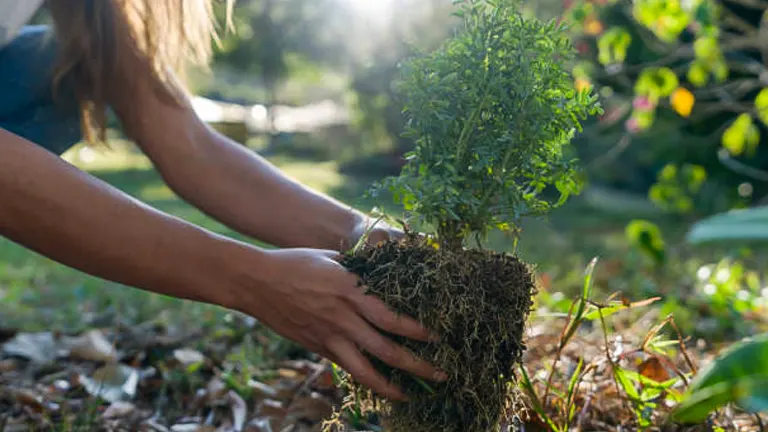
Easy-to-grow trees offer numerous benefits for the busy homeowner. Primarily, these trees require less care, reducing the need for constant monitoring and complex maintenance routines. They are generally more resistant to disease, pests, and variable weather conditions, which ensures they are a practical choice for both novice and experienced gardeners alike.
Importance of Choosing the Right Trees
Selecting the right trees for your backyard is crucial for both the health of your garden and the ease of maintenance. The ideal trees should thrive in your local climate and soil conditions without needing excessive watering, fertilizing, or pruning. They should also align with your landscaping goals, whether it’s enhancing privacy, providing shade, or simply adding aesthetic appeal.
Factors to Consider:
- Climate Compatibility: The tree must thrive in your area’s temperature ranges and seasonal changes.
- Soil Conditions: Certain trees do better in specific types of soil, be it clay, loam, or sandy.
- Growth Rate and Size: Consider how large the tree will grow and how quickly it will reach maturity, ensuring it fits well in your available space without overcrowding.
- Maintenance Needs: Look for trees that do not require constant care beyond the occasional pruning and seasonal care.
Top 10 Easy-to-Grow Trees for Your Backyard
1. Silver Maple (Acer saccharinum)
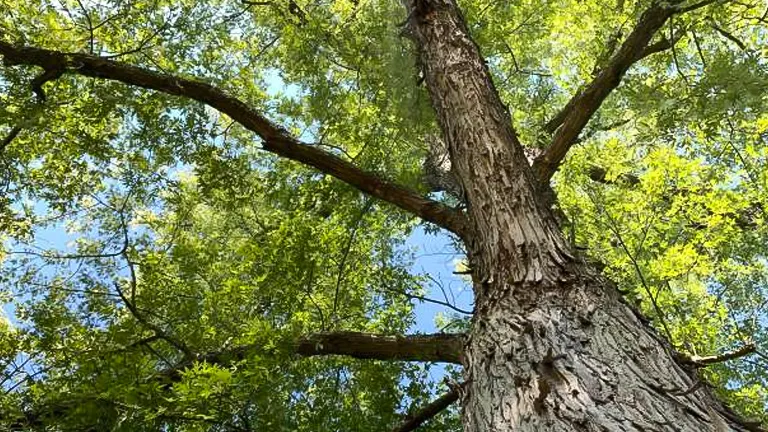
The Silver Maple, scientifically known as Acer saccharinum, is a favored choice among homeowners looking to quickly enhance their backyard with a substantial shade tree. This tree is celebrated for its rapid growth rate, often reaching impressive heights of 50 to 80 feet. Its five-lobed leaves are a striking feature, showcasing a vibrant green on the upper side and a distinctive silvery-white underneath, which shimmer and flutter beautifully in the breeze. This visual appeal, combined with its adaptability to various soil conditions, makes the Silver Maple a versatile and attractive addition to any landscape.
Growing Tips
- Planting: For optimal growth, select a location with full sun to partial shade. While the Silver Maple is highly adaptable, it thrives best in moist, slightly acidic soil. Planting during the dormant season (early spring or fall) can help the tree establish more effectively.
- Care: Consistent watering is crucial during the first few years and during dry spells to ensure healthy growth. Regular pruning in late winter to early spring helps shape the tree and remove any weak or damaged branches.
- Considerations: Due to its rapid growth, the wood can become brittle, making it prone to limb breakage. Therefore, it’s advisable to plant the Silver Maple away from structures to prevent potential damage.
Additional Information
- Fast Growth: One of the fastest-growing trees, ideal for quickly establishing shade and presence in the landscape.
- Soil Tolerance: Highly adaptable to a wide range of soil types, including clay, loam, and sandy soils.
- Aesthetic Appeal: The unique leaf coloration adds a dynamic visual contrast and movement to the landscape.
- Shade Provider: Broad canopy offers substantial shade, which can reduce cooling costs in the summer.
- Wildlife Habitat: Provides shelter and food for various birds and small mammals, enhancing local biodiversity.
- Low Maintenance: Requires minimal care once established, making it suitable for both novice and experienced gardeners.
| Specification | Details |
|---|---|
| Scientific Name | Acer saccharinum |
| Common Name | Silver Maple |
| Family | Sapindaceae |
| Native Range | Eastern and Central United States |
| Mature Height | 50 to 80 feet |
| Mature Spread | 35 to 50 feet |
| Growth Rate | Fast (over 24 inches per year) |
| Lifespan | 80 to 100 years |
| Leaf Description | Five-lobed leaves, green on top, silvery-white underneath |
| Preferred Soil Type | Moist, slightly acidic; tolerates various soils |
| Sunlight Requirements | Full sun to partial shade |
| Hardiness Zones | USDA Zones 3-9 |
| Water Requirements | Medium; consistent moisture, especially in dry spells |
| Pruning Needs | Late winter to early spring |
| Wildlife Attraction | Attracts birds and small mammals |
| Special Features | Tolerant of urban conditions |
| Potential Issues | Brittle wood; surface roots can interfere with sidewalks and driveways |
The Silver Maple is an excellent addition to any landscape, offering rapid growth, substantial shade, and year-round visual interest. Its adaptability to different soil types and low maintenance needs make it a practical choice for many gardeners. Proper placement and care will ensure that this majestic tree thrives, enhancing your backyard for many years to come.
2. Northern Catalpa (Catalpa speciosa)
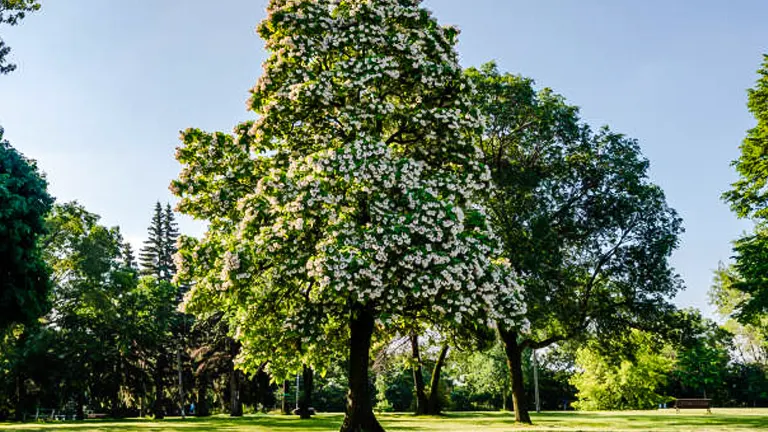
The Northern Catalpa, scientifically known as Catalpa speciosa, is notable for its large, heart-shaped leaves and showy, fragrant white flowers that bloom in late spring. This tree adds significant visual appeal to any landscape and is particularly attractive to hummingbirds and bees. The Northern Catalpa can grow up to 60 feet tall but remains relatively slender compared to other shade trees, making it a suitable option for smaller spaces.
Growing Tips
- Planting: Prefers full sun but can tolerate light shade. It performs well in most soil types, including rocky or sandy soils.
- Care: Water moderately; the Catalpa is drought-tolerant once established. It requires little pruning and is generally low-maintenance.
- Considerations: The large leaves can create a significant amount of litter when they drop, so placement away from pools or patios might be wise.
Additional Information
- Flowering: Produces large, fragrant white flowers in late spring, adding a spectacular visual and olfactory element to the garden.
- Wildlife Attraction: Attracts hummingbirds, bees, and other pollinators, contributing to the health of the local ecosystem.
- Drought Tolerance: Once established, it can withstand periods of drought, reducing the need for frequent watering.
- Low Maintenance: Requires minimal care, making it a good choice for gardeners seeking a tree that doesn’t need constant attention.
| Specification | Details |
|---|---|
| Scientific Name | Catalpa speciosa |
| Common Name | Northern Catalpa |
| Family | Bignoniaceae |
| Native Range | Central and Eastern United States |
| Mature Height | Up to 60 feet |
| Mature Spread | 20 to 40 feet |
| Growth Rate | Moderate to fast |
| Lifespan | 50 to 150 years |
| Leaf Description | Large, heart-shaped leaves |
| Preferred Soil Type | Tolerates various soils, including rocky and sandy |
| Sunlight Requirements | Full sun to light shade |
| Hardiness Zones | USDA Zones 4-8 |
| Water Requirements | Moderate; drought-tolerant once established |
| Pruning Needs | Minimal; primarily to remove dead or damaged wood |
| Wildlife Attraction | Attracts hummingbirds and bees |
| Special Features | Showy flowers, adaptable to various soil types |
| Potential Issues | Leaf litter can be considerable |
The Northern Catalpa is a remarkable tree that offers both beauty and functionality to your landscape. Its large, showy flowers and ability to attract pollinators make it a beneficial addition to any garden. With its adaptability to different soil types and low maintenance requirements, the Northern Catalpa is an excellent choice for gardeners looking to add a stunning yet resilient tree to their outdoor space. Proper planting and minimal care will ensure this tree thrives and continues to enhance your garden for many years.
3. Eastern Redbud (Cercis canadensis)
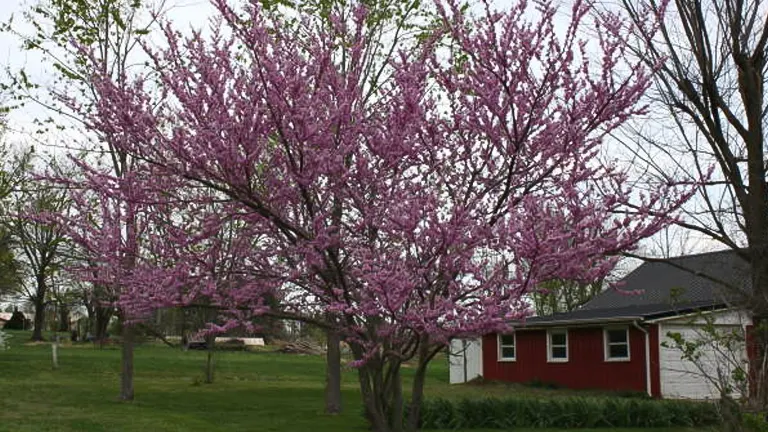
The Eastern Redbud, scientifically known as Cercis canadensis, is a beautiful and versatile small tree, often growing to about 20-30 feet tall. This tree is perfect for smaller gardens or as an understory tree in larger landscapes. The Eastern Redbud is cherished for its stunning early spring blossoms that range from pink to purple, covering the branches before the leaves emerge. These vibrant flowers create a striking visual display, making the Eastern Redbud a favorite among gardeners and landscape designers.
Growing Tips
- Planting: The Eastern Redbud thrives in partial shade but can also tolerate full sun if given adequate moisture. It prefers well-draining soil to avoid root rot. Planting in early spring or fall helps the tree establish itself more effectively.
- Care: Keep the soil consistently moist, especially during heatwaves. Mulching around the base of the tree helps retain soil moisture and protect the roots from temperature extremes.
- Considerations: The Eastern Redbud can be susceptible to canker diseases. Ensure good air circulation around the tree and avoid wounding the bark to prevent infections. Regular monitoring and timely care can mitigate these issues.
Additional Information
- Flowering: Produces beautiful pink to purple flowers in early spring, often before the leaves appear, creating a striking contrast.
- Leaf Description: Heart-shaped leaves that turn yellow in the fall, adding seasonal interest.
- Wildlife Attraction: Attracts pollinators such as bees and butterflies, enhancing local biodiversity.
- Low Maintenance: Once established, it requires minimal care, making it suitable for various garden settings.
- Adaptability: Can be grown as a single specimen tree, in groupings, or as part of a mixed border.
| Specification | Details |
|---|---|
| Scientific Name | Cercis canadensis |
| Common Name | Eastern Redbud |
| Family | Fabaceae |
| Native Range | Eastern United States |
| Mature Height | 20 to 30 feet |
| Mature Spread | 25 to 35 feet |
| Growth Rate | Moderate |
| Lifespan | 50 to 70 years |
| Leaf Description | Heart-shaped leaves, turning yellow in fall |
| Preferred Soil Type | Well-draining soil; tolerates various soil types |
| Sunlight Requirements | Partial shade to full sun |
| Hardiness Zones | USDA Zones 4-9 |
| Water Requirements | Medium; keep soil moist, especially in heatwaves |
| Pruning Needs | Minimal; prune after flowering to maintain shape |
| Wildlife Attraction | Attracts bees, butterflies, and other pollinators |
| Special Features | Early spring blossoms, heart-shaped leaves |
| Potential Issues | Susceptible to canker diseases; ensure good air circulation |
The Eastern Redbud is a delightful addition to any garden, providing early spring color, seasonal leaf interest, and benefits to local wildlife. Its moderate size and adaptability make it an excellent choice for a variety of landscape settings, from small gardens to larger mixed plantings. Proper planting and care ensure that this beautiful tree thrives and continues to enchant year after year.
4. Saucer Magnolia (Magnolia x soulangeana)
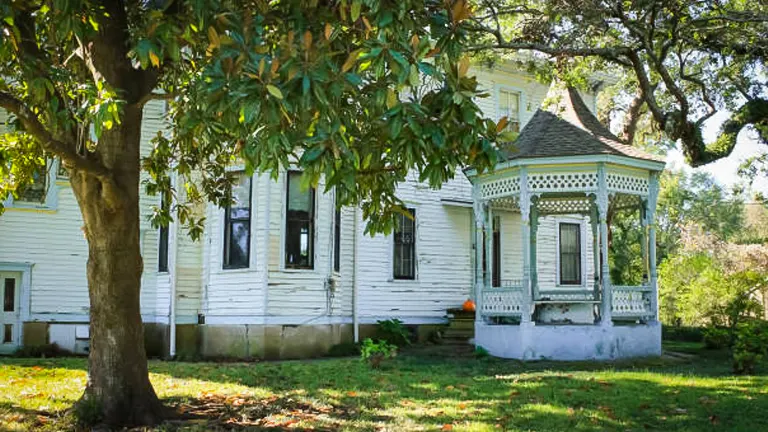
The Saucer Magnolia, scientifically known as Magnolia x soulangeana, is a hybrid ornamental tree that stands out for its large, saucer-shaped flowers. These blooms appear in early spring in striking shades of pink, purple, and white, creating a visually stunning display. The tree typically reaches a height of 20 to 30 feet, making it suitable for small to medium-sized yards. Its broad, spreading form and glossy green leaves add a lush backdrop to its beautiful flowers, making it a focal point in any landscape.
Growing Tips
- Planting: For optimal growth, plant the Saucer Magnolia in a sheltered location to protect its early blooms from spring frosts. It thrives best in well-drained, slightly acidic soil. Position the tree in full sun to partial shade, and plant it during the dormant season (early spring or fall) to help it establish more effectively.
- Care: Regular watering is essential, especially during dry periods, to maintain consistent soil moisture. Annual mulching around the base of the tree helps retain soil moisture and regulate temperature, ensuring the roots stay cool in summer and warm in winter.
- Considerations: Although the Saucer Magnolia is relatively low-maintenance, its root system can be sensitive to disturbance. Avoid heavy foot traffic around the base and be cautious during landscaping activities to prevent root damage.
Additional Information
- Flowering: Produces large, saucer-shaped flowers in early spring with colors ranging from pink to purple and white, offering a spectacular floral display.
- Leaf Description: Broad, ovate leaves that are dark green and glossy, providing a lush backdrop to the flowers.
- Wildlife Attraction: Attracts pollinators such as bees and butterflies, contributing to the garden’s biodiversity.
- Low Maintenance: Once established, it requires minimal care, making it a good choice for gardeners seeking a beautiful yet easy-to-care-for tree.
- Adaptability: Suitable for use as a specimen tree, in group plantings, or as part of a mixed border.
| Specification | Details |
|---|---|
| Scientific Name | Magnolia x soulangeana |
| Common Name | Saucer Magnolia |
| Family | Magnoliaceae |
| Native Range | Hybrid origin (cross between Magnolia denudata and Magnolia liliiflora) |
| Mature Height | 20 to 30 feet |
| Mature Spread | 20 to 25 feet |
| Growth Rate | Moderate |
| Lifespan | 80 to 120 years |
| Leaf Description | Broad, ovate leaves; dark green and glossy |
| Preferred Soil Type | Well-drained, slightly acidic |
| Sunlight Requirements | Full sun to partial shade |
| Hardiness Zones | USDA Zones 4-9 |
| Water Requirements | Medium; consistent moisture, especially during dry periods |
| Pruning Needs | Minimal; prune after flowering to maintain shape |
| Wildlife Attraction | Attracts bees and butterflies |
| Special Features | Large, showy flowers; fragrant blooms |
| Potential Issues | Sensitive root system; protect from heavy foot traffic |
The Saucer Magnolia is an exceptional addition to any garden, providing early spring color and fragrance, lush green foliage, and benefits to local wildlife. Its moderate size and adaptability make it a versatile choice for various landscape settings, from small yards to larger garden compositions. With proper planting and care, this magnificent tree will thrive and continue to bring beauty and enjoyment to your outdoor space for many years.
5. American Sycamore (Platanus occidentalis)
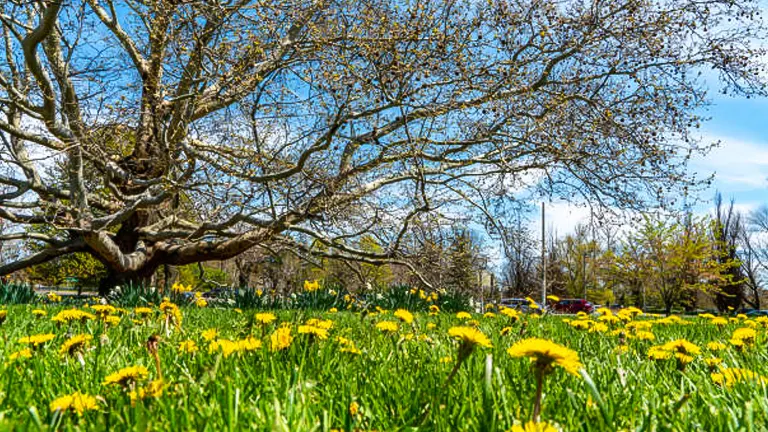
The American Sycamore, scientifically known as Platanus occidentalis, is a majestic and iconic tree notable for its massive size and distinctive peeling bark. This deciduous tree can reach towering heights of up to 100 feet, making it an excellent choice for providing extensive shade. The bark peels away in patches, revealing a striking mosaic of white, gray, and green beneath, adding unique visual interest year-round. In the fall, its broad, maple-like leaves turn a beautiful golden hue, enhancing the seasonal appeal of your landscape.
Growing Tips
- Planting: The American Sycamore thrives in full sun and is highly adaptable to various soil conditions, including wet soils near rivers and lakes. For optimal growth, plant in a location with ample space to accommodate its extensive root system and large canopy.
- Care: Once established, Sycamores are robust and require minimal maintenance. They benefit from occasional pruning to remove diseased or broken limbs, which helps maintain tree health and structure. Regular watering during dry spells can support its growth, especially in the first few years.
- Considerations: Due to its large size and extensive root system, ensure there is ample space for the tree to grow without interfering with structures, sidewalks, or driveways. The shedding bark and large leaves can create some litter, so it’s best planted away from areas where debris might be problematic.
Additional Information
- Massive Size: Can grow up to 100 feet tall with a similar spread, providing significant shade.
- Distinctive Bark: Peeling bark creates a mosaic of colors, adding year-round visual interest.
- Fall Foliage: Leaves turn golden in the fall, adding seasonal beauty to the landscape.
- Wildlife Habitat: Provides shelter and food for various birds and small mammals.
- Soil Adaptability: Tolerates a wide range of soil types, including wet and poorly drained soils.
- Longevity: Long-lived tree, often surviving for several hundred years with proper care.
| Specification | Details |
|---|---|
| Scientific Name | Platanus occidentalis |
| Common Name | American Sycamore |
| Family | Platanaceae |
| Native Range | Eastern and Central United States |
| Mature Height | 75 to 100 feet |
| Mature Spread | 50 to 70 feet |
| Growth Rate | Fast (up to 2 feet per year) |
| Lifespan | 200 to 600 years |
| Leaf Description | Broad, maple-like leaves; turn golden in fall |
| Preferred Soil Type | Moist, well-drained; tolerates wet soils |
| Sunlight Requirements | Full sun |
| Hardiness Zones | USDA Zones 4-9 |
| Water Requirements | Medium to high; prefers consistent moisture |
| Pruning Needs | Occasional; to remove diseased or broken limbs |
| Wildlife Attraction | Attracts birds and small mammals |
| Special Features | Distinctive peeling bark; massive size |
| Potential Issues | Shedding bark and leaves can create litter; requires ample space |
The American Sycamore is a majestic addition to any large landscape, providing extensive shade and unique visual interest through its distinctive bark and seasonal foliage. Its adaptability to various soil conditions and robust nature make it a resilient and low-maintenance choice for gardeners looking to add a long-lived, stately tree to their property. Proper placement and care will ensure that this tree thrives and enhances your landscape for generations.
6. Crabapple (Malus)
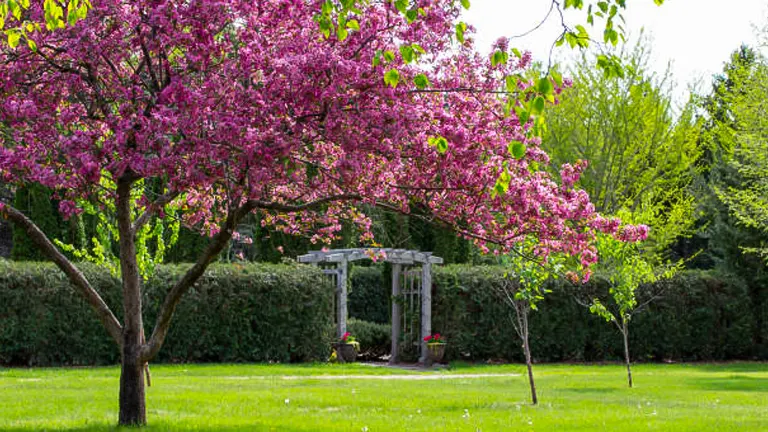
The Crabapple tree, scientifically classified under the genus Malus, is cherished for its stunning spring blossoms and vibrant fall fruits. These ornamental trees are compact, typically reaching heights of 15 to 25 feet, making them perfect for small to medium-sized gardens. The flowers, which bloom in a range of colors from white and pink to deep red, create a spectacular display in spring. In the fall, the small, colorful fruits not only add visual interest but also attract various birds, contributing to local biodiversity.
Growing Tips
- Planting: Crabapple trees thrive in full sun and well-drained soil. Planting them in open areas ensures maximum sun exposure and good air circulation, which are crucial for preventing diseases and promoting overall health.
- Care: Water the trees regularly during their early years to establish a strong root system. During periods of drought, additional watering is necessary to maintain tree health. Pruning should be done annually to maintain a strong structure and remove any diseased, damaged, or crossing branches.
- Considerations: Select disease-resistant varieties to minimize maintenance and ensure a healthier tree. Common diseases include apple scab, fire blight, and cedar-apple rust. Regular monitoring and proper care can mitigate these issues.
Additional Information
- Flowering: Produces a stunning array of flowers in spring, with colors ranging from white and pink to deep red.
- Fruit Description: Small, colorful fruits appear in fall, providing visual interest and food for wildlife.
- Wildlife Attraction: Attracts birds and beneficial insects, enhancing local biodiversity.
- Versatility: Suitable for use as a specimen tree, in group plantings, or as part of a mixed border.
- Low Maintenance: Disease-resistant varieties reduce the need for intensive care.
| Specification | Details |
|---|---|
| Scientific Name | Malus |
| Common Name | Crabapple |
| Family | Rosaceae |
| Native Range | Native to various regions across the Northern Hemisphere |
| Mature Height | 15 to 25 feet |
| Mature Spread | 15 to 25 feet |
| Growth Rate | Moderate |
| Lifespan | 30 to 70 years |
| Leaf Description | Oval, serrated leaves; green in summer, yellow in fall |
| Preferred Soil Type | Well-drained soil; tolerates a range of soil types |
| Sunlight Requirements | Full sun (at least 6 hours of direct sunlight per day) |
| Hardiness Zones | USDA Zones 4-8 |
| Water Requirements | Regular watering, especially during establishment and drought periods |
| Pruning Needs | Annual pruning to maintain structure and health |
| Wildlife Attraction | Attracts birds, bees, and other pollinators |
| Special Features | Spectacular spring blossoms; colorful fall fruits |
| Potential Issues | Susceptible to apple scab, fire blight, and cedar-apple rust |
The Crabapple tree is a versatile and beautiful addition to any garden, providing year-round interest with its spring flowers and fall fruits. Its compact size and wide range of varieties make it suitable for various landscape designs. By choosing disease-resistant varieties and providing proper care, you can enjoy the beauty and benefits of Crabapple trees with minimal maintenance.
7. Hawthorn (Crataegus)
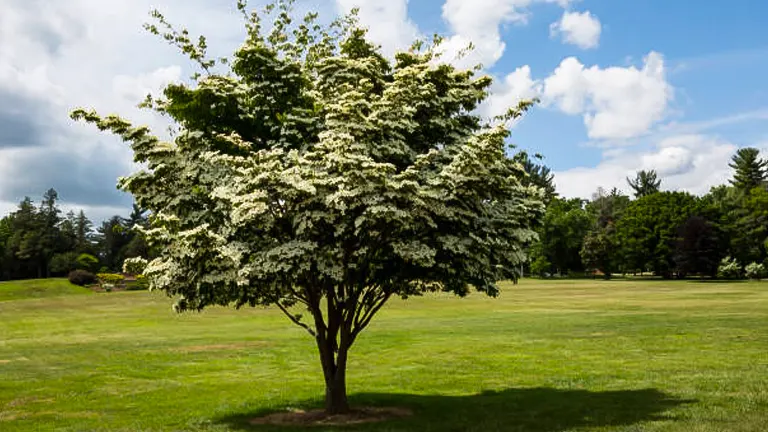
The Hawthorn tree, scientifically classified under the genus Crataegus, is a rugged yet beautiful tree that adds year-round interest to any landscape. Known for its dense clusters of white flowers that bloom in spring, followed by bright red berries in autumn, the Hawthorn is a magnet for wildlife, attracting birds and pollinators. Typically growing to a height of 15 to 30 feet, this tree is well-suited for a variety of garden sizes and settings.
Growing Tips
- Planting: Hawthorn trees thrive in full sun to partial shade and adapt well to most soil types, although they prefer well-drained soil. Planting in the early spring or fall helps the tree establish its roots effectively.
- Care: Regular watering during dry spells is crucial to maintain the tree’s health, especially in its early years. Pruning should be done sparingly and mainly to remove dead or diseased wood or to maintain the tree’s natural shape.
- Considerations: When planting near pedestrian areas, be mindful of the thorns. Choosing a thornless variety, such as the ‘Winter King’ Hawthorn, can mitigate potential issues. Also, ensure good air circulation to prevent fungal diseases.
Additional Information
- Flowering: Dense clusters of white flowers appear in spring, creating a striking display.
- Fruit Description: Bright red berries follow the flowers in autumn, providing food for birds and adding visual interest.
- Wildlife Attraction: Attracts birds, bees, and other pollinators, enhancing local biodiversity.
- Thorns: Many varieties have sharp thorns, so placement and variety selection are important considerations.
- Versatility: Can be used as a specimen tree, in hedgerows, or as part of a wildlife garden.
| Specification | Details |
|---|---|
| Scientific Name | Crataegus |
| Common Name | Hawthorn |
| Family | Rosaceae |
| Native Range | Northern Hemisphere, especially Europe, Asia, and North America |
| Mature Height | 15 to 30 feet |
| Mature Spread | 15 to 25 feet |
| Growth Rate | Moderate |
| Lifespan | 50 to 150 years |
| Leaf Description | Simple, toothed leaves; varying shades of green |
| Preferred Soil Type | Well-drained; adaptable to most soil types |
| Sunlight Requirements | Full sun to partial shade |
| Hardiness Zones | USDA Zones 4-8 |
| Water Requirements | Regular watering, especially during dry spells |
| Pruning Needs | Minimal; prune to remove dead or diseased wood |
| Wildlife Attraction | Attracts birds and pollinators |
| Special Features | Dense clusters of flowers; bright red berries; thorny branches |
| Potential Issues | Susceptible to fungal diseases like rust and leaf spot |
The Hawthorn tree is a resilient and attractive addition to any garden, offering seasonal beauty with its spring flowers and autumn berries. Its adaptability to various soil types and its ability to attract wildlife make it a versatile and beneficial tree for enhancing your landscape. By selecting the right variety and providing appropriate care, you can enjoy the many benefits of the Hawthorn tree for years to come.
8. Japanese Maple (Acer palmatum)
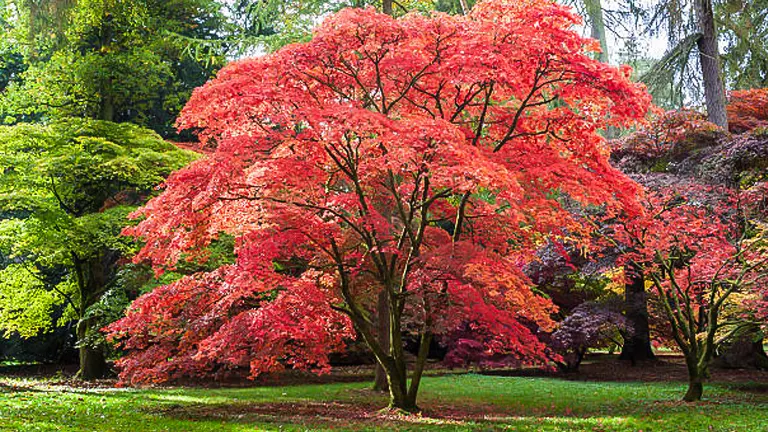
The Japanese Maple, scientifically known as Acer palmatum, is a highly esteemed ornamental tree renowned for its exquisite leaf shapes and vibrant colors, which range from deep reds to bright greens. These trees are relatively small, typically reaching heights of 15 to 25 feet, making them ideal for enhancing the beauty of smaller landscapes. Their delicate, finely lobed leaves and graceful branching structure make them a focal point in any garden.
Growing Tips
- Planting: Japanese Maples thrive best in partial shade, where they are protected from harsh winds and intense afternoon sun, which can scorch their delicate leaves. They prefer slightly acidic, well-draining soil. Planting in early spring or fall helps them establish well.
- Care: Maintain consistent soil moisture to keep the Japanese Maple healthy, but avoid waterlogging, which can damage the roots. Applying mulch around the base helps retain soil moisture and protect the roots from extreme temperatures.
- Considerations: Due to their delicate foliage, Japanese Maples should be placed in sheltered locations to prevent leaf scorch from strong sunlight or wind. Additionally, they can be sensitive to late frosts, which can damage new growth.
Additional Information
- Leaf Coloration: The foliage displays a wide range of colors, from deep reds and purples to bright greens, which can change with the seasons.
- Compact Size: Ideal for small gardens, patios, and as a container plant due to its manageable size.
- Aesthetic Appeal: Adds dramatic visual interest with its striking leaf shapes and colors, especially in the fall when the leaves turn vibrant shades.
- Wildlife Attraction: Provides habitat and food for various birds and beneficial insects.
- Low Maintenance: Requires minimal pruning and general care once established.
| Specification | Details |
|---|---|
| Scientific Name | Acer palmatum |
| Common Name | Japanese Maple |
| Family | Sapindaceae |
| Native Range | Japan, Korea, China |
| Mature Height | 15 to 25 feet |
| Mature Spread | 15 to 25 feet |
| Growth Rate | Slow to moderate |
| Lifespan | 100 years or more |
| Leaf Description | Finely lobed leaves; colors range from deep red to vibrant green |
| Preferred Soil Type | Slightly acidic, well-draining soil |
| Sunlight Requirements | Partial shade |
| Hardiness Zones | USDA Zones 5-8 |
| Water Requirements | Consistent moisture; avoid waterlogging |
| Pruning Needs | Minimal; prune to maintain shape and remove deadwood |
| Wildlife Attraction | Attracts birds and beneficial insects |
| Special Features | Stunning leaf shapes and colors; graceful branching structure |
| Potential Issues | Susceptible to leaf scorch from strong sunlight; sensitive to late frosts |
The Japanese Maple is a remarkable addition to any garden, offering exceptional beauty through its varied leaf colors and shapes. Its compact size makes it suitable for smaller landscapes, patios, and even container gardening. By providing the right care and planting conditions, this elegant tree will thrive and enhance your garden’s aesthetic for many years.
9. Leyland Cypress (Cupressocyparis leylandii)
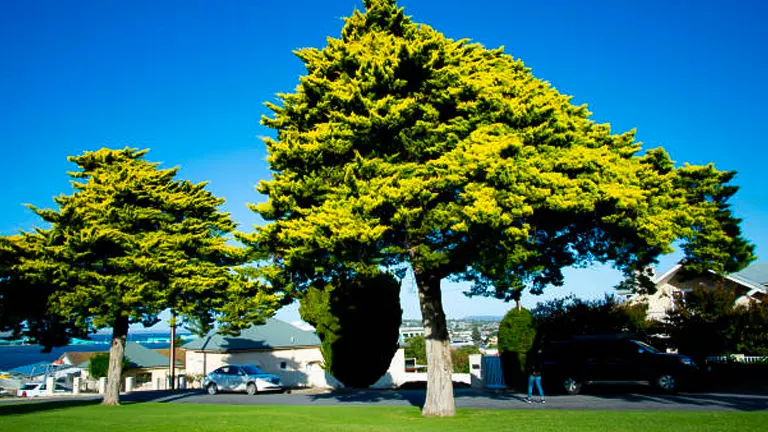
The Leyland Cypress, scientifically known as Cupressocyparis leylandii, is a highly sought-after tree for creating privacy screens and windbreaks due to its rapid growth rate and dense, evergreen foliage. If left untrimmed, it can reach impressive heights of 60 to 70 feet, but it is easily maintained at a desired height through regular pruning. Its feathery, dark green foliage provides year-round coverage, making it an excellent choice for property borders and large hedges.
Growing Tips
- Planting: Leyland Cypress thrives in full sun and can adapt to a wide range of soil types, provided they are well-drained. For optimal growth, space the trees 6 to 10 feet apart to ensure adequate air circulation and room for development. Planting in early spring or fall is recommended to allow the roots to establish before extreme weather conditions.
- Care: Regular watering is crucial, especially during the first few years and throughout the growing season, to help establish a strong root system. Once established, the tree is relatively drought-tolerant. Annual pruning is necessary to maintain the desired shape and density, and to prevent the tree from becoming too large and unmanageable.
- Considerations: Given its rapid growth and large size, it’s important to plant the Leyland Cypress at a sufficient distance from buildings, fences, and other structures to allow room for expansion. Additionally, its dense foliage can sometimes become a breeding ground for pests and diseases if not properly maintained, so regular inspection and maintenance are essential.
Additional Information
- Rapid Growth: One of the fastest-growing conifers, making it ideal for quickly establishing privacy screens and windbreaks.
- Dense Foliage: Provides excellent year-round coverage and privacy.
- Versatility: Can be used for formal hedges, property borders, or as individual specimen trees.
- Low Maintenance: Requires minimal care once established, aside from regular pruning to control size.
- Wind Resistance: Strong, flexible branches make it an effective windbreak.
| Specification | Details |
|---|---|
| Scientific Name | Cupressocyparis leylandii |
| Common Name | Leyland Cypress |
| Family | Cupressaceae |
| Native Range | Hybrid origin (cross between Monterey Cypress and Nootka Cypress) |
| Mature Height | 60 to 70 feet (can be maintained at shorter heights with pruning) |
| Mature Spread | 10 to 15 feet |
| Growth Rate | Very fast (up to 3 feet per year) |
| Lifespan | 25 to 50 years |
| Leaf Description | Dark green, feathery foliage; evergreen |
| Preferred Soil Type | Well-drained; tolerates a variety of soil types |
| Sunlight Requirements | Full sun |
| Hardiness Zones | USDA Zones 6-10 |
| Water Requirements | Regular watering during establishment and growing season |
| Pruning Needs | Annual pruning to maintain shape and control size |
| Wildlife Attraction | Provides shelter for birds |
| Special Features | Fast growth; dense, evergreen foliage |
| Potential Issues | Susceptible to canker disease and root rot if not properly maintained |
The Leyland Cypress is a versatile and fast-growing tree, perfect for creating privacy screens and windbreaks. Its dense, evergreen foliage provides year-round coverage and visual appeal. By planting and maintaining it correctly, you can enjoy a robust and attractive barrier that enhances your landscape.
10. Flowering Dogwood (Cornus florida)
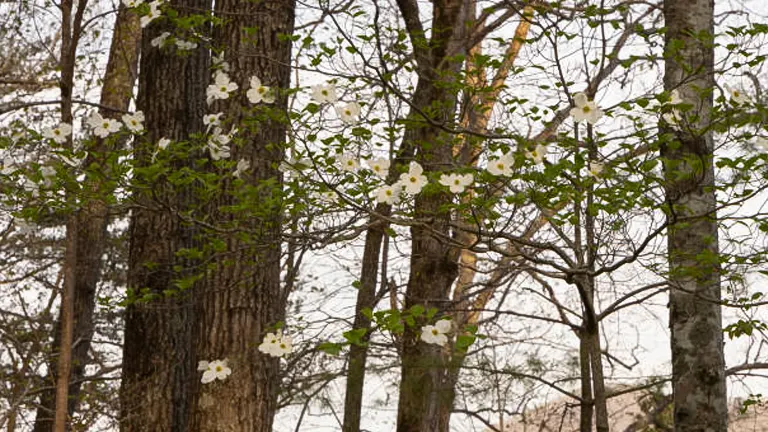
The Flowering Dogwood, scientifically known as Cornus florida, is a beloved ornamental tree known for its stunning springtime blossoms and vibrant fall fruits. The flowers, which can be white, pink, or even reddish, create a breathtaking display in spring, while the bright red berries attract birds and add seasonal interest. Typically growing to heights of 20 to 30 feet, the Flowering Dogwood is well-suited to a variety of garden settings, providing beauty and ecological benefits.
Growing Tips
- Planting: The Flowering Dogwood thrives in partial shade, where it is protected from the harsh afternoon sun, which can cause leaf burn. It prefers well-drained, acidic soil, rich in organic matter. Planting in early spring or fall allows the tree to establish its roots before the onset of extreme temperatures.
- Care: Moderate watering is essential, especially during dry spells. Mulching around the base helps retain soil moisture and keeps the roots cool. Mulch also helps to suppress weeds and adds organic matter to the soil as it decomposes.
- Considerations: Flowering Dogwoods are susceptible to several pests and diseases, including dogwood anthracnose and powdery mildew. Proper spacing and good air circulation are crucial to reduce the risk of these issues. Additionally, ensure that the tree is not exposed to prolonged wet conditions, which can promote fungal diseases.
Additional Information
- Flowering: Produces showy flowers in spring, ranging from white to pink, which can last for several weeks.
- Fall Color: Leaves turn a brilliant red or purple in the fall, adding to the tree’s seasonal interest.
- Wildlife Attraction: The bright red fruits attract birds and other wildlife, providing a valuable food source.
- Versatility: Ideal for use as a specimen tree, in woodland gardens, or as part of a mixed border.
- Cultural Significance: Often used in landscaping for its beauty and symbolic value in many cultures.
| Specification | Details |
|---|---|
| Scientific Name | Cornus florida |
| Common Name | Flowering Dogwood |
| Family | Cornaceae |
| Native Range | Eastern United States |
| Mature Height | 20 to 30 feet |
| Mature Spread | 25 to 30 feet |
| Growth Rate | Slow to moderate |
| Lifespan | 80 to 100 years |
| Leaf Description | Oval, dark green leaves; turn red or purple in fall |
| Preferred Soil Type | Well-drained, acidic soil |
| Sunlight Requirements | Partial shade |
| Hardiness Zones | USDA Zones 5-9 |
| Water Requirements | Moderate; requires more water during dry conditions |
| Pruning Needs | Minimal; primarily to remove dead or diseased wood |
| Wildlife Attraction | Attracts birds and other wildlife |
| Special Features | Showy flowers; vibrant fall foliage; attractive fruits |
| Potential Issues | Susceptible to dogwood anthracnose, powdery mildew, and leaf spot |
The Flowering Dogwood is a beautiful and versatile tree that brings year-round interest to any garden. Its stunning spring flowers, vibrant fall foliage, and attractive fruits make it a standout choice for ornamental planting. Proper care and placement will ensure that this tree thrives and enhances your landscape for many years.
Ongoing Care and Maintenance
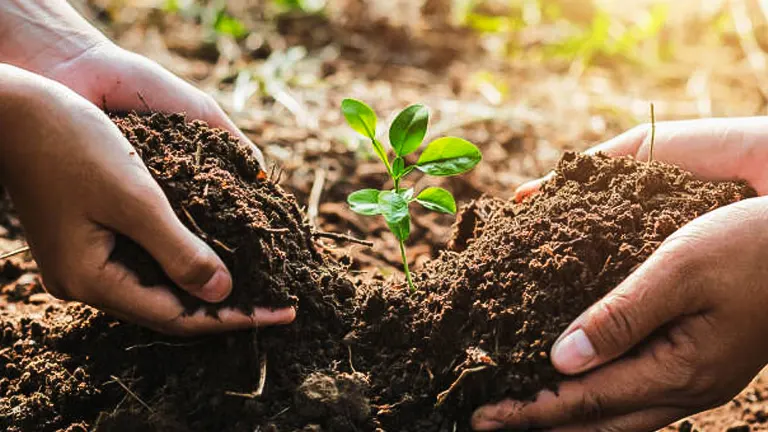
Once your trees are planted, ongoing care is crucial to ensure they grow healthy and strong. This section covers the key aspects of tree maintenance, tailored to the needs of easy-to-grow trees.
Regular Watering
While newly planted trees need consistent watering to establish, ongoing watering remains important especially during dry spells. The frequency and amount will depend on the tree type and local climate conditions. A good rule of thumb is to ensure the soil around the tree is moist but not waterlogged. Use a soaker hose or drip irrigation to deliver water directly to the roots, promoting deeper root growth and water efficiency.
Seasonal Pruning
Pruning is essential not only to maintain a tree’s shape and aesthetic appeal but also to ensure its health and safety. Prune during the dormant season to remove dead or diseased branches, to shape the tree, and to prevent potential hazards like branches growing too close to power lines or structures. For flowering trees, timing your pruning right after the blooming period ensures you don’t accidentally cut off next year’s buds.
Fertilization
Most easy-to-grow trees require minimal fertilization, but an annual check can help determine if your trees need a nutrient boost, particularly if they show signs of slowed growth or pale leaves. Use a balanced fertilizer suited to your specific tree species and soil conditions, applying it according to package directions usually in the spring.
Pest and Disease Management
Keeping an eye on the health of your trees can help catch any issues early before they become severe. Regularly inspect the leaves, branches, and trunk for signs of pests or disease. Integrated pest management strategies that include biological controls, mechanical barriers, or chemical treatments should be used responsibly and as needed, based on local extension advice to minimize environmental impact.
Common Problems and Solutions
Despite the best care, trees can sometimes encounter problems. Here are a few common issues and how to address them:
- Leaf Scorch: Often caused by insufficient watering or excessive sun, ensure adequate water during dry periods and consider sun protection strategies if necessary.
- Root Rot: Caused by overwatering or poor drainage. Make sure your planting site is well-drained and adjust watering practices.
- Pests: Aphids, borers, and mites are common. Use appropriate insecticides or natural predators like ladybugs for control.
- Diseases: Fungal infections like powdery mildew or leaf rust require fungicidal treatments. Keep the area around your trees clean and well-maintained to reduce these risks.
Benefits of Having Trees in Your Backyard
Incorporating trees into your backyard isn’t just about aesthetics; it’s about creating a healthier, more sustainable living environment. Here are several compelling reasons to plant trees at home:
Environmental Benefits
- Air Quality Improvement: Trees absorb pollutants and exhale clean oxygen, improving the air quality around your home.
- Wildlife Habitat: Trees provide shelter and food for birds, insects, and other wildlife, enhancing local biodiversity.
- Energy Savings: Properly placed trees can reduce the need for air conditioning in summer by shading your home and can block cold winds in winter, reducing heating costs.
Psychological and Social Benefits
- Stress Reduction: Studies have shown that spending time near trees and green spaces can lower blood pressure and reduce stress.
- Aesthetic Value: Trees add beauty and character to your property, which can be calming and pleasing to the eye.
- Increased Property Value: Well-landscaped yards with mature trees are often more valuable, potentially increasing your home’s market price.
Landscape Design Ideas with These Trees
Integrating trees into your landscape design should be both functional and beautiful. Here are some design ideas to help you get the most out of planting trees:
Create a Natural Privacy Screen
- Use fast-growing trees like Leyland Cypress or American Sycamore to form a natural barrier that enhances privacy while buffering noise.
Design an Outdoor Living Space
- Arrange trees to frame and shade a patio, deck, or garden seating area, creating a comfortable outdoor living space for relaxation and entertainment.
Accentuate Seasonal Colors
- Plant trees like the Eastern Redbud or Saucer Magnolia that offer vibrant seasonal flowers or foliage to bring dynamic changes to your landscape throughout the year.
Develop a Wildlife-Friendly Garden
- Choose trees like the Crabapple or Hawthorn, which produce fruits that attract birds and beneficial insects, contributing to local ecology.
Related Post
- How to Build a Barn: A Step-by-Step Guide for Beginners
- How to Build a Sustainable Compost Bin: Easy and Eco-Friendly DIY
- How to Fertilize Bougainvillea: A Complete Guide for Stunning Blooms
- How to Fertilize Apple Trees: Essential Tips for a Bountiful Harvest
- How to Fertilize Lemon Trees: Secrets for Thriving Citrus
- How to Fertilize Avocado Tree: A Step-by-Step Guide for Lush Growth
- 10 Best Bow Saws to Buy in 2024: Top Picks for the Money
- Best Miter Saw For Beginners
- Top 10 Pruning Saws to Buy in 2024: Best for the Money
- 7 Best Pocket Chainsaw
Conclusion
Planting trees in your backyard offers a multitude of benefits, from enhancing your home’s curb appeal to contributing to your physical and mental well-being. The trees listed in this guide provide not only environmental and aesthetic advantages but also thrive with minimal maintenance, making them ideal choices for any homeowner.
FAQs
- What are the top considerations for selecting drought-resistant trees for arid climates?
For arid climates, prioritize species that naturally thrive in low-water conditions, such as the Silver Maple or Saucer Magnolia. Consider the tree’s root system efficiency, foliage density, and heat tolerance. - Can I plant different types of easy-to-grow trees close together for a varied landscape?
Yes, you can mix different types of trees, but ensure each has enough space for root and canopy growth. Consider their varying needs for sunlight, water, and nutrients to avoid competition and ensure healthy growth. - How do I protect young trees from winter damage?
Wrap the trunks with tree guards to prevent frost cracking and rodent damage. Mulching helps regulate soil temperature, and for very young trees, consider temporary windbreaks. - What are the best easy-to-grow trees for attracting wildlife?
Trees that produce fruits or nuts, like the Crabapple and Hawthorn, are excellent for attracting birds and beneficial insects, enhancing your backyard’s biodiversity. - Is there a way to speed up the growth of easy-to-grow trees?
While these trees are already selected for their growth efficiency, ensuring optimal soil conditions, adequate watering, and proper fertilization can help maximize their growth rate. - How can I use easy-to-grow trees to reduce noise pollution?
Planting a row of dense trees such as Leyland Cypress can help dampen noise from busy roads or neighbors. The more foliage and the denser the barrier, the more sound will be absorbed. - What maintenance practices should I avoid to prevent harming my easy-to-grow trees?
Avoid over-pruning, which can stress trees and make them vulnerable to diseases. Also, refrain from overwatering and applying too much fertilizer, which can lead to root rot and nutrient burn. - How do I choose trees that will complement the existing plants in my garden?
Select trees with compatible growth requirements and aesthetic characteristics that match or enhance your garden’s theme. Consider bloom time, foliage color, and overall size to harmonize with existing plants.
Ready to transform your backyard into a haven of greenery? With these top 10 easy-to-grow trees, you’re well on your way to creating a low-maintenance, beautiful outdoor space that thrives. Start planting today and enjoy the shade and beauty for years to come!
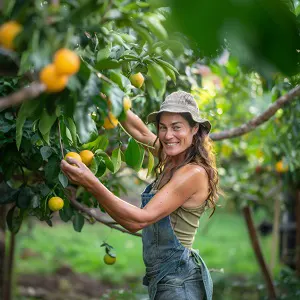
Emma Hudson
Forestry AuthorEmma's experience in farming shapes her detailed guides on gardening and farming tools, providing practical, actionable advice grounded in real-world experience. Her work targets both newcomers and experienced farmers, aiming to enhance their practices with a mix of traditional wisdom and modern techniques. By making complex agricultural concepts accessible, Emma's guides serve as valuable tools for those navigating the challenges of contemporary farming, offering strategies for sustainable success.






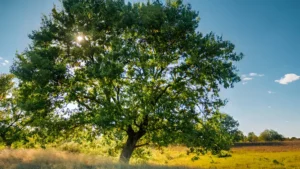






Leave your comment